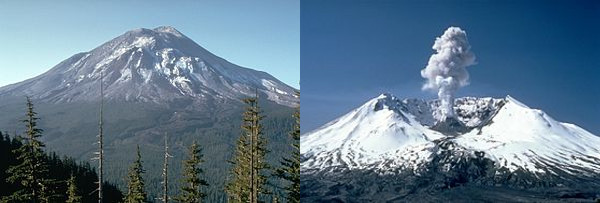April 1, 2012
Recent research in volcanology has concentrated on improving the predictability of major eruption events with the primary aim of providing sufficient warning to enable evacuation of personnel from the danger zone.
A breakthrough in understanding the underlying mechanism of eruption events has recently emerged from research teams headquartered in The Netherlands under the leadership of Professor Art Stierkaak. The key finding is that eruption events are triggered not, as previously understood, by an increase of magma pressure in a subterranean chamber, but instead by the release of stored energy in the volcano’s isohypse pattern in a process known as an ‘Isohypse Reconnection Event’.
It is well known that volcanoes grow incrementally by extrusion of lava via the central vent. New lava adds additional layers to the existing volcanic cone, each of which represent an increase in the potential energy of the rock mass contained within the cone. This energy is stored in the isohypses, or contour lines, of the cone which become increasingly stretched by each new addition of lava to the cone. New isohypses are also added to the top of the cone every time the peak height increases. These new isohypses will be stretched by the next addition of lava.
Isohypses therefore behave like rubber bands which get more and more stretched with each new discharge of lava. Over time, vast amounts of energy become ‘frozen in’ to the isohypses because the mobility of the volcanoes is effectively zero, thereby preventing controlled dissipation of the stored energy into the surrounding medium.
An Isohypse Reconnection Event arises when the stress in the isohypses exceeds the breaking strength of the isohypses. The weakest isohypse will break first and trigger a catastrophic cascade of failures as the stress is redistributed among the remaining isohypses, which then become overstressed and fail in turn.
Professor Stierkaak’s breakthrough has been to identify the reason why apparently stable isohypses can suddenly fail. His team have discovered that the isohypses themselves degrade over time as the material of the isohypse vulcanises and becomes more brittle. When that happens, stress concentrations arising from minor scratches or other defects on the surface of an isohypse are no longer relieved by microscopic plastic deformation of the atomic structure of the isohypse but instead result in development of a stress crack. This stress crack can rapidly propagate through the full depth of the isohypse and result in catastrophic failure, leading to an Isohypse Reconnection Event.
The energy released in the Isohypse Reconnection Event causes the volcano to explode and results in the relaxation of the highly-stressed isohypses to lower energy levels as large volumes of volcanic rock are redistributed at lower elevations.
Art Stierkaak says of his team’s discovery, ‘With this breakthrough in understanding, we can now monitor the vulcanisation of the isohypses and predict with more certainty the likelihood of a catastrophic failure. We should all be much safer from unexpected Isohypse Reconnection Events from now on’.
Bob Johnson













